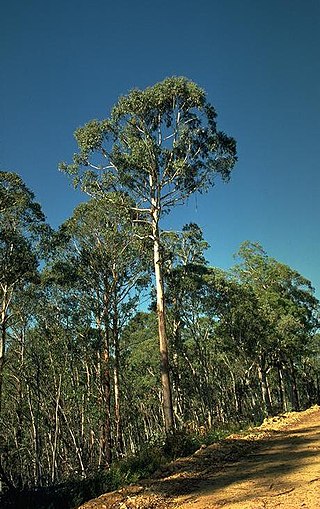
Eucalyptus delegatensis, commonly known as alpine ash, gum-topped stringybark, white-top and in Victoria as woollybutt, is a species of tree that is endemic to southeastern Australia. It has a straight trunk with rough, fibrous to stringy bark on the lower half of the trunk, smooth white bark above, lance-shaped to curved adult leaves, flower buds in groups of between seven and fifteen, white flowers and barrel-shaped or hemispherical fruit.

Eucalyptus macrorhyncha, commonly known as the red stringybark, is a species of medium-sized tree that is endemic to eastern Australia. It has rough, stringy, grey to brown bark, lance-shaped adult leaves, flower buds in groups of between seven and eleven, white flowers and hemispherical fruit.

Eucalyptus baxteri, commonly known as brown stringybark, is a medium-sized tree that is endemic the south-east of Australia. It has rough, stringy bark to the thinnest branches, lance-shaped or curved adult leaves, green to yellow flower buds in groups of between nine and fifteen, and cup-shaped or hemispherical fruit.

Eucalyptus laevopinea, commonly known as the silver top stringybark, is a tree that is endemic to eastern Australia. It has rough, stringy greyish bark on the trunk and larger branches, glossy green, lance-shaped adult leaves, flower buds in groups of between seven and eleven, white flowers and hemispherical or shortened spherical fruit.
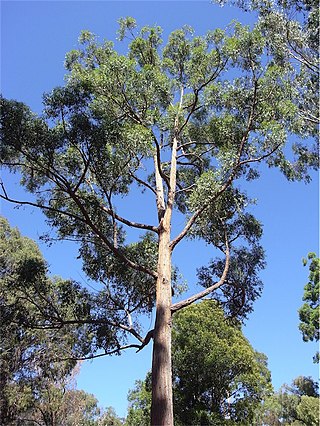
Eucalyptus tindaliae, commonly known as Tindal's stringybark, is a species of tree that is endemic to coastal eastern Australia. It has rough, stringy bark on the trunk and larger branches, lance-shaped to curved adult leaves, flower buds in groups of between nine and fifteen, white flowers and hemispherical fruit.

Eucalyptus blaxlandii, commonly known as Blaxland's stringybark, is a tree that is endemic to south eastern New South Wales. It is a stringybark with lance-shaped adult leaves, flower buds arranged in group of nine or eleven, white flowers and hemispherical fruit.

Eucalyptus ligustrina, commonly known as the privet-leaved stringybark, is a species of shrub, mallee or small tree that is endemic to New South Wales. It has rough, stringy bark, lance-shaped to egg-shaped adult leaves, flower buds in groups of between seven and fifteen, white flowers and hemispherical or shortened spherical fruit.

Eucalyptus tenella, commonly known as narrow-leaved stringybark, is a species of small to medium-sized tree that is endemic to New South Wales. It has stringy bark, narrow lance-shaped to linear leaves, flower buds in group of seven to fifteen, white flowers and hemispherical fruit.
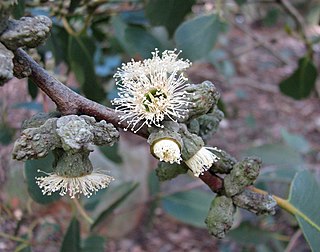
Eucalyptus verrucata, commonly known as Mount Abrupt stringybark, is a species of shrub or a small tree that is endemic to the Grampians in Victoria, Australia. It has smooth bark, rough bark on the base of older trees, egg-shaped to elliptical adult leaves, flower buds usually singly in groups of three in leaf axils, white flowers and cup-shaped or hemispherical fruit.

Eucalyptus serraensis, commonly known as the Grampians stringybark, is a species of small tree or mallee that is endemic to the Grampians in Victoria, Australia. It has rough, stringy, fibrous or flaky bark on the trunk and sometimes also the branches, smooth bark above, lance-shaped to egg-shaped or round adult leaves, sessile flower buds in groups of three or seven, white flowers and hemispherical or cup-shaped fruit.
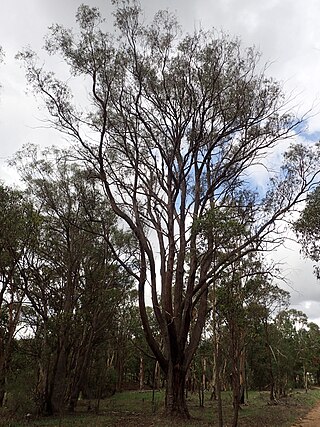
Eucalyptus youmanii, commonly known as Youman's stringybark, is a species of small to medium-sized tree that is endemic to eastern Australia. It has rough, stringy bark on the trunk and branches, lance-shaped or curved adult leaves, flower buds in groups of seven, white flowers and hemispherical fruit.

Eucalyptus williamsiana, commonly known as the large-leaved stringybark, is a species of small to medium-sized tree that is endemic to northern New South Wales. It has rough, stringy bark on the trunk and branches, broadly lance-shaped adult leaves, flower buds in groups of seven, white flowers and hemispherical fruit.
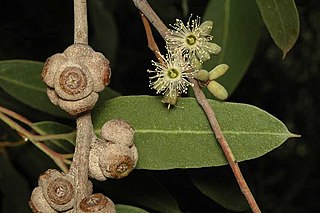
Eucalyptus bensonii, commonly known as Benson's stringybark, is a small tree or mallee that is endemic to New South Wales. It has rough grey or brown stringy bark on the trunk and larger branches, smooth bark on the thinnest branches, broadly lance-shaped to egg-shaped adult leaves, flower buds arranged in groups of seven, nine or eleven, white flowers and cup-shaped or hemispherical fruit in clusters.

Eucalyptus boliviana, commonly known as Bolivia Hill stringybark or Bolivia stringybark is a shrub or a mallee, sometimes a small tree and is endemic to a small area in northern New South Wales. It is a stringybark with four-sides stems, broadly lance-shaped adult leaves, flower buds arranged in groups of seven, yellow flowers and hemispherical to broadly funnel-shaped fruit.

Eucalyptus psammitica, commonly known as bastard white mahogany, is a species of small to medium-sized tree that is endemic to eastern Australia. It has rough, stringy or fibrous, prickly bark on the trunk and branches, lance-shaped to curved adult leaves, flower buds in groups of between seven and eleven, white flowers and cup-shaped to hemispherical fruit.
Eucalyptus quinniorum, commonly known as monkey gum, is a species of mallee or a small to medium-sized tree that is endemic to northern New South Wales. It has smooth bark with persistent, stringy bark near the base, linear to narrow lance-shaped adult leaves, flower buds in groups of seven, white flowers and hemispherical to cylindrical fruit.
Eucalyptus optima, is a species of small to medium-sized tree or a mallet that is endemic to a small area in the south of Western Australia. It has smooth white to greyish bark, sometimes with rough black bark on the base of the trunk, lance-shaped adult leaves, flower buds in groups of seven or nine, pale yellow flowers and cup-shaped, hemispherical or urn-shaped fruit.
Eucalyptus mackintii, commonly known as the blue-crowned stringybark, is a species of medium-sized tree that is endemic to Victoria. It has rough, stringy bark on the trunk and branches, lance-shaped to curved adult leaves, flowers buds in groups of between seven and eleven, white flowers and cup-shaped or hemispherical fruit.

Eucalyptus sphaerocarpa, commonly known as the Blackdown stringybark, is a species of tall forest tree that is endemic to Queensland. It has rough, stringy bark on the trunk and branches, lance-shaped to curved adult leaves, flower buds in groups of seven, nine or eleven, white flowers and shortened spherical fruit.
Eucalyptus aurifodina, commonly known as the small-leaved brown stringybark is a rare small tree that is endemic to the goldfields area of Victoria. It has rough, stringy bark on its trunk and branches, glossy green elliptic to egg-shaped adult leaves, oval or slightly club-shaped buds arranged in groups of seven to eleven, white flowers and hemispherical fruit.















